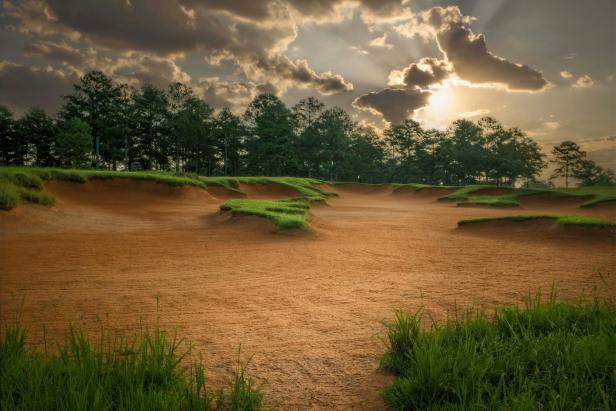In the lead up to the 1953 U.S. Open at Oakmont Country Club, there was a clash between the USGA and club officials over the use of heavy, wide-tined bunker rakes. This led to a compromise where the furrowing rakes would only be used in greenside bunkers. Over time, the retirement of Oakmont’s furrows illustrates how attitudes towards bunkers have changed, with a shift towards fairness and uniformity on golf courses. Architects began to focus on utility and aesthetic composition rather than creating overly penal bunker hazards.
Recently, there has been a resurgence in bunker wickedness, with architects embracing the poignancy and peril of penalty by crafting deep, wind-whipped prairie traps and other visually arresting hazards. Architect Gil Hanse’s cave bunker at The Park West Palm exemplifies this trend, with bunkers designed to provide playing options without tailored convenience for players. Historically, bunkers were seen as hazards to be avoided at all costs, and were essential markers on golf courses that gained notoriety with colorful names like “Himalayas” and “Hell.”
As attitudes towards golf shifted to stroke play and a focus on livelihood, there was a growing antipathy towards overly penal bunkers. Television coverage of professional golfers like Arnold Palmer and Jack Nicklaus led to a boom in golf participation and a demand for fair and consistent playing conditions on courses. This led to a trend of renovating older courses to mellow out hazards and make them more playable.
While some designers like Robert Trent Jones intensified the shot demands of their courses by deepening bunkers, others like Tom Fazio and Arthur Hills focused on creating more helpful and artistic bunkers. The bunker awakening occurred in the 1990s with Sand Hills Golf Club, where architects Bill Coore and Ben Crenshaw created choppy and punishing hazards that reflected natural blowouts in the Sandhills region. Their success inspired a new era of more rugged and naturalistic bunker expressions in golf course design.
Designers like Coore, Crenshaw, and others took inspiration from the past, building bunkers that emphasized tactical error and consequences. The movement to reconstruct original design features of architects like MacKenzie and Tillinghast invigorated bunkers and led to a more irreverent approach to golf course design. The focus shifted towards creating thought-provoking holes, even if they trended towards severity, with a recognition that fairness is not a key component of the historical golf code.
Golfers’ relationships with bunkers have become more complex, with professionals and recreational players expecting predictability and consistency in bunker conditions. The USGA even modified rules to allow for the removal of loose impediments in bunkers. Ultimately, bunkers are meant to be hazards that come with a cost, serving the purpose of challenging and intriguing players. Fairness is not the main goal of bunkers, but rather creating interest and stimulating strategic play on the golf course.
